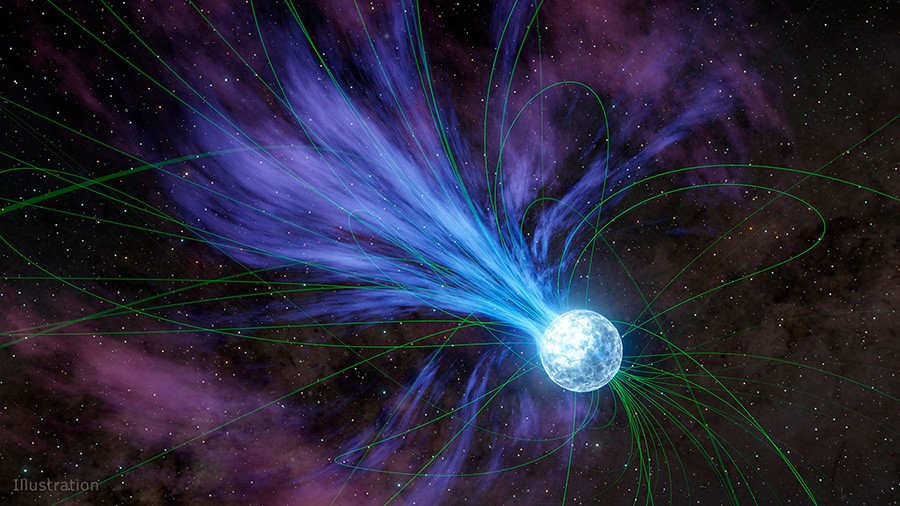There was a great opportunity to understand the mysterious, periodic radio emissions known as fast radio bursts, when such a source was born in our galaxy. SGR 1935+2154, a neutron star with a very strong magnetic field, or magnetar, issued a signal similar to a fast radio burst (FRB) on April 28, 2020, and astronomers have already had the opportunity to observe an FRB in our galaxy. alive.
The researchers waited for the next eruption, which occurred in October 2022, and this time they were prepared.
Until 2020, almost all known FRBs originated from distant galaxies. Each of them releases more energy in a fraction of a second than the Sun releases in a year. Some of them repeated the trick. For a while, there were at least as many theories about their origin as there were fast radio bursts. Now, by observing the explosion coming from our galaxy, astronomers know that at least some of it is caused by magnetars, but how?
Chen-Ping Hu (National Changhua University of Education, Taiwan) and colleagues received an explosion warning from NASA's INTEGRAL space telescope, and then observed the magnetar using two other space telescopes, NICER and NuSTAR.
The researchers observed the neutron star's rotation by tracking a hot spot on the surface of the magnetar. The dot probably represents one pole of the star's magnetic field. As the hot spot appears in the field of view 3.2 times per second, the neutron star's light appears to pulse. The NICER space telescope was specifically designed to record changes in such short time periods.
NuSTAR provided the spectrum data, so researchers could pinpoint the source of the radiation. The hot spot emits X-rays because it is very hot, and charged particles in the neutron star's strong magnetic field also emit X-rays.
A few hours later, astronomers noticed dramatic changes in the city-sized star, just 20 kilometers away. The neutron star initially suddenly began to spin faster, then the rotation slowed down continuously for four hours, resulting in a powerful radio burst (detected by the CHIME radio telescope in Canada). Another sudden phase jump came another four hours later, and the star was rotating faster again. Researchers report on a phenomenon called “glitching” in the February 14 issue of Nature It has been reported.
The star's spectrum showed that most of the X-ray emission during the two phase jumps came from the hot spot. However, in the time before the radio burst and during the explosion, as well as the time between the two faults, the radiation from the magnetically trapped particles increased.
Neutron stars produce an unexpected phase jump when their surface is out of sync with their interior. “It's not a perfect analogy, but it's like water in a rotating spherical aquarium. Imagine the water rotating faster than the glass bowl itself. Later, the glass catches up with the water – that's rotational disturbance.”
A phase jump occurs when the subsurface motions of a neutron star compress the crust, causing it to crack during a starquake. This is most likely to happen near the hotspot.
If the neutron star's rotation period were shortened by even a fraction of a second, the energy of the earthquake could be enormous. In the case of a celestial body that is 20 kilometers long and rotates around its axis in 3.2 seconds, the surface is rotating at a speed of 11,000 kilometers per hour, so any small change in this assumes a lot of energy.
What is interesting about the rotation of SGR 1935+2154 is not the sudden phase jump itself, but the fact that the rotation then slowed down in such a short time. Most neutron stars accrete within weeks or months after such an event, but this magnetar only needs a few hours to return to its previous rotation rate.
This can be explained if electrically charged particles are also ejected in the form of short-lived stellar winds during the phase jump associated with the stellar quake. These stellar winds can deprive the star of faster rotation at almost the same speed as its output.
Hence, because all the particles are in an extremely strong magnetic field, much stronger than any magnetic field on Earth, the conditions are just right for an extreme event. Particles (i.e. electrons and their antimatter pairs, positrons) are born in pairs of magnetic field energy, and as a result, as he puts it, an “avalanche” begins.
“One electron creates a pair, then each offspring creates many other pairs, and so on, over several generations, until a single electron has thousands of offspring.” “These electron-positron pairs will eventually be responsible for the sudden radio burst in a laser-like process,” says Hu. he adds.
“This observation links a rare fast radio burst to a rare double-phase jump and clearly points the way for further studies of fast radio bursts.” says Laura Spitler (Max Planck Institute for Radio Astronomy), an expert in fast radio bursts who was not involved in the research. It remains to be seen whether this is true for all fast radio bursts, but it is a great advance from an observational point of view.
Aside from the 2020 and 2022 outbursts, no other powerful radio bursts have been detected from SGR 1935+2154, but weaker activity occurs frequently on the star. The researchers plan to continue monitoring the magnetar to see if they detect additional explosions that could provide new data for the stellar wind coupling scenario.
source: Sky and telescope
comment












































